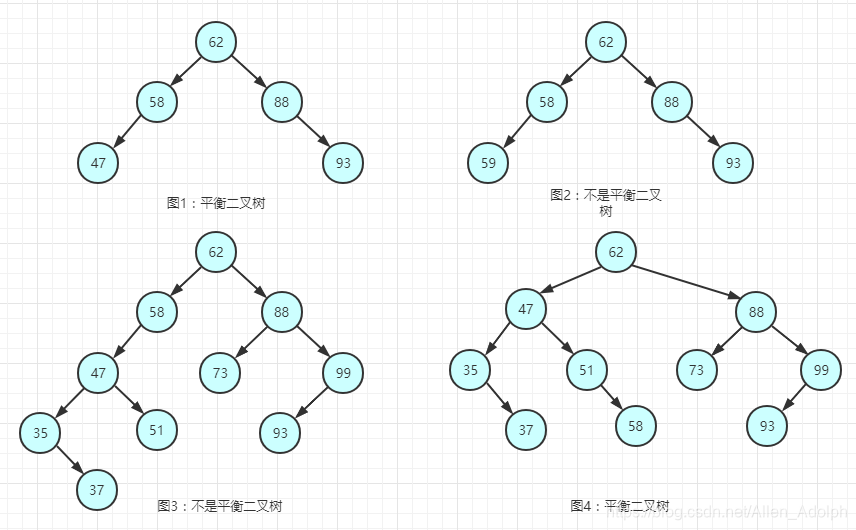一、平衡二叉树起步
1. 基本概念
平衡二叉树(AVL)可以很好地解决二叉搜索树中退化为链表的问题,从上一篇文章了解到二叉搜索树的性能取决于树的形状,当我们以升序或者降序的顺序往二叉搜索树中插入数据时,将会造成类似下图右的情况,此时时间复杂度为O(n),二叉树退化为链表,没有得到二叉树应有的效率,所以平衡二叉树应运而生。

首先平衡二叉树也是一颗二叉搜索树,它也满足二叉搜索树的特性。但除此之外,它还有一个重要的特性:每一个节点的左子树和右子树的高度差最多为1。因为这个高度差限制从而避免了上述的最坏情况,因此查找、插入和删除的效率也可以保持在O(lg n)。
2. 平衡因子
平衡因子:为了反映每个节点的高度差,平衡二叉树在二叉搜索树的基础上,在节点中添加了一个新的域,称为平衡因子(BF)。平衡因子代表了当前节点左子树深度减去右子树深度的值。根据前面平衡二叉树所提及的性质,我们可以直到,对于平衡二叉树,每个节点中的平衡因子只能是-1、0、1这三种可能。
接下来简单示例一下:

- 图1是平衡二叉树,树中所有节点的平衡因子都在
-1、0、1这个集合中。同样图4也是平衡二叉树; - 图2不是平衡二叉树,甚至不是二叉搜索树,59大于58,但是确是58这个节点的右子树;
- 图3不是平衡二叉树,58这个节点的左子树深度减去右子树深度等于2,不属于
-1、0、1这个集合;
二、 旋转
前面提到,平衡二叉树中每个节点的平衡因子需要控制在{-1、0、1}三个数值中,那么当某个节点的平衡因子不属于这三个值,就需要通过某种操作将平衡因子控制在{-1、0、1}中,这种操作就称之为旋转。旋转根据情况可分为左旋转和右旋转,现在先来了解一下什么是旋转。

如图1所示,当1这个节点插入树中时,3这个节点的左子树深度减去右子树深度为2,那么此时就需要旋转,将图1修正到图2的形式;当4节点插入时,平衡因子还在范围内,所以不用进行旋转;

当插入节点5之后,节点3的平衡因子变化成了-2,此时需要通过对节点3进行左旋转修正为上图图5的形式;现在对旋转应该有了大致的了解,接下来介绍旋转的几种情况:
1. LL型

当我们向一个已经达到平衡状态的树中插入9这个元素,如上图所示。此时16这个点的左子树减去右子树等于2,所以需要将以16为根节点的这个子树进行右旋转,达到有图的平衡状态,这种情况子树以及子树的子树都在左边的情况,称为LL型,需要用到右旋转操作,简单用伪代码示例以下:
public void rotateRight(Node h) { // h为失衡节点,下面简称根节点
Node x = h.left; // 根结点的左孩子保存为x
h.left = x.right; // 根结点左孩子的右孩子挂到根结点的左孩子上
x.right = h; // 根结点挂到根结点左孩子的右孩子上
h = x; // 根结点的左孩子代替h称为新的根结点
}
当然实际的代码比上面的伪代码复杂些,这里简单示例一下,后面再详细说明。
2. RR型

当向一个已经达到平衡状态的树中插入26这个元素,如上图所示,此时7这个节点的左子树减去右子树等于-2,处于非平衡状态,需要将以7为根节点的树进行左旋转,如上图所示。
3. LR型

LR型与RL稍微比较难以理解些,上图平衡树在插入7后,16这个节点达到失衡状态,此时不能直接将以16为根节点的子树进行右旋转,否则会像上图右边所示,7比3大,却在3的左边,这样不符合二叉搜索树的要求。所以要先进行左旋转(注意:不是以16这个节点为根的子树进行左旋转,而是16这个节点的左子树进行左旋转),然后再以16为根的子树进行右旋转。
4. RL型

RL型的情况与LR型的情况差不多,不能直接进行旋转,需要现对失衡节点的右子树进行右旋转,然后再对以失衡节点为根的子树进行左旋转。
5. 小结
对上面所述的四种情况,我在网上看见一张不错的图,用以小结一下:

上图来源:https://blog.csdn.net/Ascend2015/article/details/87796641
三、代码解析
1. 平衡调整
在插入完数据后,对节点进行平衡因子计算,之后再判断是左子树还是右子树高,在通过平衡因子判断是是否为LR型或RL型,再进行左旋右旋的操作,代码如下所示:其中node.depth是指该节点的深度,用以被其父节点计算平衡因子,BF则为平衡因子。
// 从插入的过程回溯回来后,计算平衡因子
node.depth = calcDepth(node);
node.BF = calcBF(node);
if (node.BF >= 2) { // 左子树高,可能是LL型或LR型
if (node.left.BF == -1) { // 判断是否是LR型
// LR型的话,需要先进行左旋
LeftRotate(node.left);
}
// 右旋
RightRotate(node);
}
if (node.BF <= -2) { // 左子树高,可能是RR型或RL型
if (node.right.BF == 1) { // 判断是否是RL型
// RL型的话,需要先进行右旋
RightRotate(node.right);
}
// 左旋
LeftRotate(node);
}
2. 计算平衡因子
计算平衡因子的代码实现十分简单,就是用节点的左子树高度减去右子树高度
// 计算传入节点处的平衡因子
private int calcBF(Node node) {
int left_depth, right_depth; // 定义左右子树的高度
left_depth = node.left == null ? 0 : node.left.depth;
right_depth = node.right == null ? 0 : node.right.depth;
return left_depth - right_depth;
}
3. 计算节点高度
计算节点的深度,就是将左右节点中较高的一边的高度再加上1,即为当前节点的高度了。
// 计算深度
private int calcDepth(Node node) {
int depth = 0;
if (node.left != null) {
depth = node.left.depth;
}
if (node.right != null && depth < node.right.depth) {
depth = node.right.depth;
}
return ++depth;
}
四、测试代码
以下为测试代码,写得匆忙,有错请指出。
public class AVLTree<Key extends Comparable<Key>, Value> {
private Node root;
private class Node {
private Key key;
private Value value;
private Node parent, left, right; // 父节点,左右子节点
private int depth; // 定义深度
private int BF; // 定义平衡因子
public Node(Key key, Value value) {
this.key = key;
this.value = value;
depth = 1;
BF = 0;
}
}
// 插入数据
public void put(Key key, Value value) {
if (root == null) { // root为空,新插一个
root = new Node(key, value);
}
put(root, key, value);
}
private Node put(Node node, Key key, Value value) {
if (node == null) {
return new Node(key, value); // 新建一个节点
}
int cmp = key.compareTo(node.key);
if (cmp < 0) {
// 在node的左子树插入
node.left = put(node.left, key, value);
node.left.parent = node;
} else if (cmp > 0) {
// 在node的右子树插入
node.right = put(node.right, key, value);
node.right.parent = node;
} else {
// 当前键已经存在,则更新当前键对应的值
node.value = value;
}
// 从插入的过程回溯回来后,计算平衡因子
node.depth = calcDepth(node);
node.BF = calcBF(node);
if (node.BF >= 2) { // 左子树高,可能是LL型或LR型
if (node.left.BF == -1) { // 判断是否是LR型
// LR型的话,需要先进行左旋
LeftRotate(node.left);
}
// 右旋
RightRotate(node);
}
if (node.BF <= -2) { // 左子树高,可能是RR型或RL型
if (node.right.BF == 1) { // 判断是否是RL型
// RL型的话,需要先进行右旋
RightRotate(node.right);
}
// 左旋
LeftRotate(node);
}
// 平衡本节点后,重新计算平衡因子与深度
node.BF = calcBF(node);
node.depth = calcDepth(node);
return node;
}
// 计算传入节点处的平衡因子
private int calcBF(Node node) {
int left_depth, right_depth; // 定义左右子树的高度
left_depth = node.left == null ? 0 : node.left.depth;
right_depth = node.right == null ? 0 : node.right.depth;
return left_depth - right_depth;
}
// 计算深度
private int calcDepth(Node node) {
int depth = 0;
if (node.left != null) {
depth = node.left.depth;
}
if (node.right != null && depth < node.right.depth) {
depth = node.right.depth;
}
return ++depth;
}
// 左旋 // 等等这里画一幅图
private void LeftRotate(Node node) {
Node parent = node.parent;
int flag = 0;
if (parent != null) {
flag = node.equals(parent.left) ? 0 : 1;
}
Node temp = node.right;
if (temp.left != null) {
node.right = temp.left;
node.right.parent = node;
} else {
node.right = null;
}
temp.left = node;
node.parent = temp;
temp.parent = parent;
if (parent != null) {
if (flag == 0) parent.left = temp;
else parent.right = temp;
} else {
// 如果等于null,证明原来的node是root,所以旋转后的temp得作为root
root = temp;
}
// 重新计算平衡因子与深度
node.BF = calcBF(node);
node.depth = calcDepth(node);
temp.BF = calcBF(temp);
temp.depth = calcDepth(temp);
}
// 右旋
private void RightRotate(Node node) {
Node parent = node.parent;
int flag = 0; // 用来标识当前节点是其父节点的左孩子还是右孩子节点,0表示左孩子,1表示右孩子
if (parent != null) {
flag = node.equals(parent.left) ? 0 : 1;
}
Node temp = node.left;
if (temp.right != null) {
node.left = temp.right;
node.left.parent = node;
} else {
node.left = null;
}
temp.right = node;
node.parent = temp;
temp.parent = parent;
if (parent != null) {
if (flag == 0) parent.left = temp;
else parent.right = temp;
} else {
// 如果等于null,证明原来的node是root,所以旋转后的temp得作为root
root = temp;
}
// 重新计算平衡因子与深度
node.BF = calcBF(node);
node.depth = calcDepth(node);
temp.BF = calcBF(temp);
temp.depth = calcDepth(temp);
}
public void levelOrderTraversal() {
levelOrderTraversal(root);
}
// 层序遍历
private void levelOrderTraversal(Node root) {
Queue<Node> queue = new LinkedList<Node>();
queue.offer(root);
while (!queue.isEmpty()) {
Node node = queue.poll();
System.out.print(node.key + "\t BF:" + node.BF + " \t");
if (node != root) {
System.out.print("parent:" + node.parent.key);
}
System.out.println();
if (node.left != null) {
queue.offer(node.left);
}
if (node.right != null) {
queue.offer(node.right);
}
}
}
public static void main(String[] args) {
AVLTree<Integer, String> tree = new AVLTree();
tree.put(7, "1");
tree.put(3, "2");
tree.put(11, "3");
tree.put(26, "6");
tree.put(9, "4");
tree.put(16, "5");
tree.levelOrderTraversal();
}
}